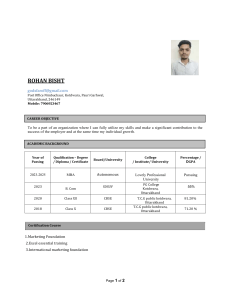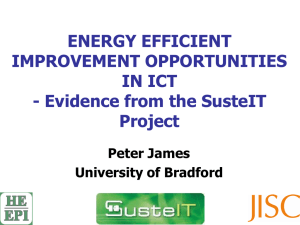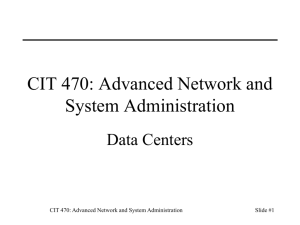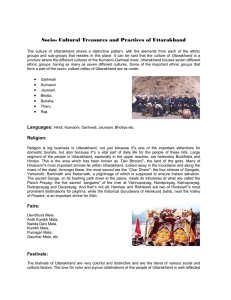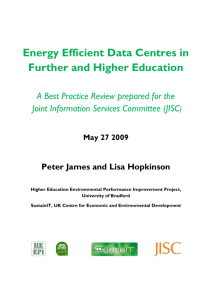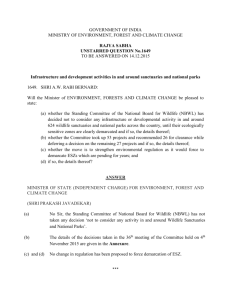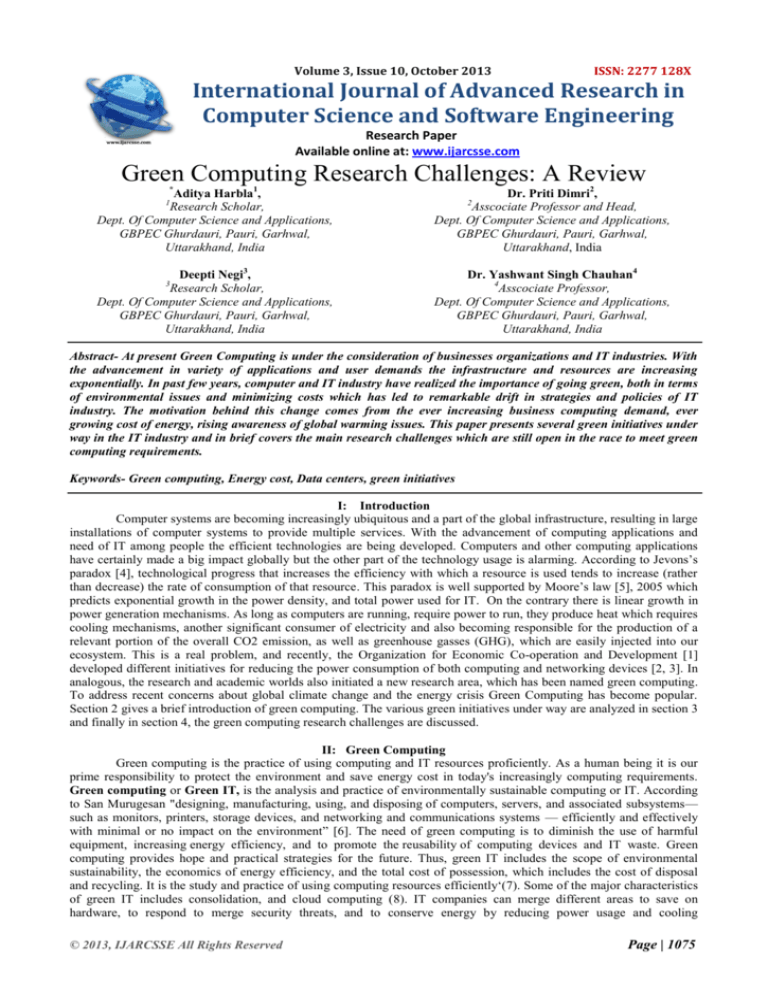
Volume 3, Issue 10, October 2013
ISSN: 2277 128X
International Journal of Advanced Research in
Computer Science and Software Engineering
Research Paper
Available online at: www.ijarcsse.com
Green Computing Research Challenges: A Review
*
Aditya Harbla1,
Research Scholar,
Dept. Of Computer Science and Applications,
GBPEC Ghurdauri, Pauri, Garhwal,
Uttarakhand, India
Dr. Priti Dimri2,
Asscociate Professor and Head,
Dept. Of Computer Science and Applications,
GBPEC Ghurdauri, Pauri, Garhwal,
Uttarakhand, India
Deepti Negi3,
Research Scholar,
Dept. Of Computer Science and Applications,
GBPEC Ghurdauri, Pauri, Garhwal,
Uttarakhand, India
Dr. Yashwant Singh Chauhan4
4
Asscociate Professor,
Dept. Of Computer Science and Applications,
GBPEC Ghurdauri, Pauri, Garhwal,
Uttarakhand, India
1
3
2
Abstract- At present Green Computing is under the consideration of businesses organizations and IT industries. With
the advancement in variety of applications and user demands the infrastructure and resources are increasing
exponentially. In past few years, computer and IT industry have realized the importance of going green, both in terms
of environmental issues and minimizing costs which has led to remarkable drift in strategies and policies of IT
industry. The motivation behind this change comes from the ever increasing business computing demand, ever
growing cost of energy, rising awareness of global warming issues. This paper presents several green initiatives under
way in the IT industry and in brief covers the main research challenges which are still open in the race to meet green
computing requirements.
Keywords- Green computing, Energy cost, Data centers, green initiatives
I: Introduction
Computer systems are becoming increasingly ubiquitous and a part of the global infrastructure, resulting in large
installations of computer systems to provide multiple services. With the advancement of computing applications and
need of IT among people the efficient technologies are being developed. Computers and other computing applications
have certainly made a big impact globally but the other part of the technology usage is alarming. According to Jevons‘s
paradox [4], technological progress that increases the efficiency with which a resource is used tends to increase (rather
than decrease) the rate of consumption of that resource. This paradox is well supported by Moore‘s law [5], 2005 which
predicts exponential growth in the power density, and total power used for IT. On the contrary there is linear growth in
power generation mechanisms. As long as computers are running, require power to run, they produce heat which requires
cooling mechanisms, another significant consumer of electricity and also becoming responsible for the production of a
relevant portion of the overall CO2 emission, as well as greenhouse gasses (GHG), which are easily injected into our
ecosystem. This is a real problem, and recently, the Organization for Economic Co-operation and Development [1]
developed different initiatives for reducing the power consumption of both computing and networking devices [2, 3]. In
analogous, the research and academic worlds also initiated a new research area, which has been named green computing.
To address recent concerns about global climate change and the energy crisis Green Computing has become popular.
Section 2 gives a brief introduction of green computing. The various green initiatives under way are analyzed in section 3
and finally in section 4, the green computing research challenges are discussed.
II: Green Computing
Green computing is the practice of using computing and IT resources proficiently. As a human being it is our
prime responsibility to protect the environment and save energy cost in today's increasingly computing requirements.
Green computing or Green IT, is the analysis and practice of environmentally sustainable computing or IT. According
to San Murugesan "designing, manufacturing, using, and disposing of computers, servers, and associated subsystems—
such as monitors, printers, storage devices, and networking and communications systems — efficiently and effectively
with minimal or no impact on the environment‖ [6]. The need of green computing is to diminish the use of harmful
equipment, increasing energy efficiency, and to promote the reusability of computing devices and IT waste. Green
computing provides hope and practical strategies for the future. Thus, green IT includes the scope of environmental
sustainability, the economics of energy efficiency, and the total cost of possession, which includes the cost of disposal
and recycling. It is the study and practice of using computing resources efficiently‗(7). Some of the major characteristics
of green IT includes consolidation, and cloud computing (8). IT companies can merge different areas to save on
hardware, to respond to merge security threats, and to conserve energy by reducing power usage and cooling
© 2013, IJARCSSE All Rights Reserved
Page | 1075
Aditya et al., International Journal of Advanced Research in Computer Science and Software Engineering 3(10),
October - 2013, pp. 1075-1077
requirements. Current IT setup relies on integration of users, networks, and resources for which green computing idea
must be applied to address increasingly difficult problems.
Green IT can be reached through reduction of energy consumption and waste. Energy management and
emissions tracking software are available. What the IT buys – from computer equipment to paper – directly impacts how
green IT is and how green its suppliers are. If an IT organization only purchases technologies with Energy Star, EPEAT,
and other energy efficiency ratings, it can significantly reduce its energy consumption and greenhouse gas footprint, and
it will help drive technology manufacturers to develop products that earn energy efficiency ratings. At the end of the
chain, a green IT function needs a waste management program.
III: Green Initiatives In Information Technology
It started way back in 1992, when the U.S. Environmental Protection Agency (EPA) launched Energy Star, a
controlled labeling program that is planned to promote and recognize energy-efficiency in monitors, climate control
equipment, and other technologies. This resulted in the widespread adoption of sleep mode among consumer electronics.
Concurrently, the Swedish organization TCO Development launched the TCO Certification program to promote low
magnetic and electrical emissions from CRT-based computer displays; this program was later expanded to include
criteria on energy usage, ergonomics, and the use of hazardous materials in construction. With time IT industry has taken
many initiatives towards green ICT (Information and Communication Technologies). The remarkable green initiatives in
IT are:
1) Improved Data Center Cooling Methods: This is achieved by improving the data center cooling configuration,
eliminating considerable amount of energy leaks. IT can result in efficient data centers by following leading practices in
data centre layout and rack and server arrangements. Effective approach include raised floors to improve airflow, moving
cooling systems closer to servers to concentrate cold air in the right place, alternating hot and cool server passageway to
improve airflow and using water-based air conditioning systems [9].
2) Efficient Servers usage by Virtualization: Generally, IT companies have been using many server farms or data
centers, dedicated to a specific task. These data servers must be efficiently used. One of the mechanisms is load
balancing which chooses the optimum resource among many. Also by using virtual software to perform these tasks, a
single server may be used to power these virtual servers, dramatically reducing energy consumption.
3) Alternative Storage Methods: Storage drives are another main element of data center infrastructure and, as
organizations storage needs increase; more energy is used to power these hard drives. It can be reduced by using large
capacity drives and performing data center audits to eliminate redundancies in the system.
4) Using Thin Clients: With thin clients, each employee has a virtual desktop that includes a mouse, keyboard and
screen while the remaining unit is shared by all at a central location.
5) Strengthen Printer’s Output Management: Centrally located printer may be used to handle all printing tasks
virtually eliminating numerous machines being left on all day sucking up energy and driving up costs.
6) Explore Alternative Sources of Energy: The efficient resource utilization leads towards efficient methods to evolve
[4]. With time renewable and natural energy sources are being used to power data centers, such as nuclear or
hydroelectric power, solar energy etc. This saves money and generates fewer CO2 emissions.
7) Energy saver initiatives: This includes using energy saving settings and encouraging employees to turn off
equipment at the end of the work day and on weekends.
8) Proper Disposal and Recycling: This is so important because it potentially eliminates the threat of harmful toxins
being released into the environment and allows for the reuse of equipment reducing the amount of waste. These
initiatives exhibit the requirement of going green. Along with above mentioned IT initiatives every sector and area of IT
is practicing green strategy and policies because sustainable development of ICT is the future need. Still there are many
open challenges in computing which are covered in following section.
IV: Open Research Challanges
Energy is one of the most valuable and scarce resources available to the world, a significant portion of which is
now being consumed to power up computers and computing infrastructure. Basically, high-performance parallel and
distributed computing system, including data centers, supercomputers, clusters, real-time systems, and grids not only
consume considerable amounts of power but also require air-conditioning to keep the systems cool. The exponential
growth in computing is rapidly increasing the consumption of precious natural resources such as oil and coal,
strengthening the alarming danger of energy shortage. These issues have been raised by the researchers from time to
time and the possible measures are being taken. Still there are many areas yet to be explored. Here we present some
notable areas of research in green computing:
1: New Optimization Techniques in Performance-Energy-Temperature aware Computing: The exponential growth
in computing activity and the rising concern for energy conservation have made energy efficiency in computers a
technological issue of prime importance. The tradeoff between Performance-Energy-Temperature has to be made for so
that the maximum benefits can be obtained. Designing techniques that are optimal with respect to performance, energy,
and temperature are utmost requirement as far as green computing research challenges are concerned.
2: Information Resource Tier Optimization:
The information resource tier represents important data base management systems in the global computation world.
General paradigms include databases, directories, file-systems, and flat files. It also includes the integration of different
© 2013, IJARCSSE All Rights Reserved
Page | 1076
Aditya et al., International Journal of Advanced Research in Computer Science and Software Engineering 3(10),
October - 2013, pp. 1075-1077
database structures so that different databases can be analyzed irrespective of their storing mechanisms and data
structure. Big data research topic is open in this field [10, 11].
3: Reduce architectural complexity: The research area is open to reduce the number of tiers and component
dependency to reduce maximum system use. Intel‘s core 2 duo is a mechanism which uses power to run only those
components which are necessary at any computation [12].
4: New high-efficiency data center design
Bigger data centers can be made much more energy efficient than smaller data centers. Standards are emerging for
measuring this, such as the concept of Power Usage Effectiveness (PUE). PUE is defined as the ratio of total facility
power divided by IT equipment power [13]. Thus, it is a measure of how much of the power being consumed by the
facility is actually being used to power the IT equipment itself rather than all the other things. Therefore it will quiet be a
challenge to make the bigger data centres power efficient
5: Developing Green Maturity Model: Full equipment life cycle is the main area for green maturity model, with energy
reduction as the best measure of ―greenness.‖ The need of maturity models for equipments, IT organizations, computing
techniques is an issue which has been addressed by some researchers but is limited to specific areas. Green maturity
model for virtualization [14] depicts that each level describes the degree of green characteristics.
7: Wireless Sensor Network for Data Center Cooling: data center cooling is a major issue as far as power
consumption is concerned. Data centers are backbone of any computing organization and must be reliable and available
at every point of time. Measuring the data center effectiveness and maintaining the baseline is an issue. Wireless sensors
could play a big role for managing data centers power management [15].
8: Green Software’s: Recently, green software movement has become a research subject for most of the software
developers companies because of need for sustainable development [16]. Most of the research has been done on the
characterization, metrics and technical answer for green software, but few have addressed green software from the
business perspective. Business organizations are moving towards green software‘s and still some considerable steps need
to be taken.
V:
Conclusion
Green computing will be the driving force of future computing. New computing innovations and applications
need to fulfill the green computing requirements for the sustainable development of Information and communication
technology (ICT). Every research challenge carries a future prospect for employing efficient computing in different
areas. We will further analyze these challenges for better understanding and future research.
References:
[1] OECD, Working Party on the Information Economy, Towards Green ICT Strategies:Assessing Policies and
Programmes on ICTs and the Environment. <http://www.oecd.org/dataoecd/47/12/42825130.pdf> (accessed
November 2011).
[2] W. Van Heddeghem, W. Vereecken, M. Pickavet, P. Demeester, Energy in ICT – trendsand research directions, in:
Proceedings of the IEEE Third International Symposium on Advanced Networks and Telecommunication Systems
(ANTS), New Delhi, 14–16 December 2009.
[3] A. Bianzino, C. Chaudet, D. Rossi, J. Rougier, A survey of green networking research, IEEE Communications
Surveys and Tutorials (2010) 1–18.
[4] http://en.wikipedia.org/wiki/Jevons_paradox
[5] http://www.mooreslaw.org/
[6] San Murugesan, ―Harnessing Green IT: Principles and Practices,‖ IEEE IT Professional, January–February 2008,
pp 24-33.
[7] Kolbasuk McGee, M. (2007), ―Data Centre Energy Consumption Has Doubled Since 2000,‖, InformationWeek, p.
1-5
[8] Arnfield, R. (2009). ―Information security goes green‖. Infosecurity, p. 33-38
[9] http://www.google.co.in/about/datacenters/efficiency/
[10] http://www.cra.org/ccc/files/docs/init/bigdatawhitepaper.pdf
[11] K. Michael and R. Clarke, ―Location and Tracking of Mobile Devices: Überveillance Stalks the Streets,‖ Computer
Law & Security Rev., vol. 29, 2013, pp. 216-228.
[12] http://www.intel.com/products/processor/core2duo/specifications.htm
[13] http://www.datacenterknowledge.com/archives/2013/09/17/google-has-spent-21-billion-on-data-centers/
[14] Ma Liangli; Chen Yanshen; Sun Yufei; Wu Qingyi, "Virtualization Maturity Reference Model for Green Software,"
Control Engineering and Communication Technology (ICCECT), 2012 International Conference on , vol., no.,
pp.573,576, 7-9 Dec. 2012
[15] Rodriguez, M.G.; Ortiz Uriarte, L.E.; Yi Jia; Yoshii, K.; Ross, R.; Beckman, P.H., "Wireless sensor network for
data-center environmental monitoring," Sensing Technology (ICST), 2011 Fifth International Conference on , vol.,
no., pp.533,537, Nov. 28 2011-Dec. 1 2011
[16] Dustdar, Schahram; Li, Fei; Truong, Hong-Linh; Sehic, Sanjin; Nastic, Stefan; Qanbari, Soheil; Vogler, Michael;
Claesens, Markus, "Green software services: From requirements to business models," Green and Sustainable
Software (GREENS), 2013 2nd International Workshop on , vol., no., pp.1,7, 20-20 May 2013
© 2013, IJARCSSE All Rights Reserved
Page | 1077

